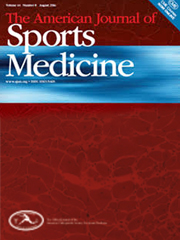PC > Qualis A1
Bone Bruise Patterns in...
Authors: Novaretti, João V.; Shin, Jason J.; Albers, Marcio; Chambers, Monique C.; Cohen, Moises; Musahl, Volker; Fu, Freddie H.
FI 6.093

AMERICAN JOURNAL OF SPORTS MEDICINE, v. Jun, p. 036354651877724, 2018
DOI: http://dx.doi.org/10.1177/0363546518777247
aluno Doutorado
Abstract
Background: Bone bruises are frequently found on magnetic resonance imaging (MRI) after anterior cruciate ligament (ACL) injury and have been related to the force associated with the trauma. Yet, little is known about the bone bruise distribution pattern of skeletally immature (SI) patients, as the presence of an open physis may play a role in energy dissipation given its unique structure.
Purpose: To describe and compare the location and distribution of tibial and femoral bone bruises, observed on MRI, between 2 groups of ACL-injured knees: the first group with an open physis and the second with a closed physis. Additionally, based on the bone bruise distribution pattern, the secondary aim of the study was to propose a new classification of bone bruise in SI patients.
Study Design: Cross-sectional study; Level of evidence, 3.
Methods: A retrospective review was conducted to identify all cases of primary ACL tears in patients ≤16 years old, with MRI within 6 weeks of injury between January 2012 and December 2016. Overall, 106 patients were identified: 53 with open physis (skeletally immature [SI] group) and 53 with closed physis as control (skeletally mature [SM] group). MRI scans were reviewed to assess for the presence and location of bone bruises. Longitudinal bone bruise distribution was described as epiphyseal and metaphyseal in both femur and tibia. The proposed classification for tibia and femur has 2 parts: the location of the bone bruise in the (I) lateral, (II) medial, or (III) medial and lateral parts of the bone; and if the bone bruise (a) does not or (b) does cross the physis. For the tibia, if the bone bruise is also present in the central portion, a letter C is added.
Results: The SI group had significantly fewer bone bruises cross the physis and extend into the metaphysis than did the SM group for both the tibia (25% vs 85%, respectively; P < .0001) and the femur (4% vs 42%; P < .0001). The most common patterns observed in the SI group were type IIICa in the tibia (medial/lateral and central, not extending into the metaphysis: 42%) and type Ia in the femur (lateral, not extending into the metaphysis: 59%).
Conclusion: The data from this study shows that patients with an open physis at the occurrence of an acute ACL rupture have unique bone bruise patterns as compared with those with a closed physis. In the SI patients, the bone bruise pattern is significantly less frequently observed in the tibial and femoral metaphysis.


